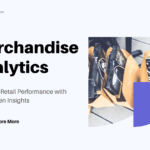Augmented analytics involves using advanced technologies like artificial intelligence, machine learning, and natural language processing to automate and enhance data analysis. In retail, augmented analytics can be used to analyze large volumes of data from multiple sources and generate insights that can help drive sales and profitability. For example, retailers can use augmented analytics to identify trends in customer behavior, forecast demand for products, optimize pricing strategies, and personalize marketing campaigns. By leveraging augmented analytics, retailers can make data-driven decisions that improve the customer experience, increase sales, and boost profits.
What is Augmented Analytics?
Augmented analytics is an advanced approach to data analysis that leverages artificial intelligence (AI) and machine learning (ML) to automate and enhance the process of extracting insights from data. Augmented analytics combines the power of data discovery, data preparation, and data visualization into a single process that delivers accurate and relevant insights to business users in real-time.
Traditional analytics involves manual data preparation, hypothesis formulation, data analysis, and interpretation of results. Augmented analytics, on the other hand, uses AI and ML algorithms to automate the process of data preparation, discover patterns and anomalies, generate insights, and provide recommendations to users. This allows business users to quickly and easily access insights and make data-driven decisions without requiring extensive technical skills or knowledge of complex data analysis techniques.
One of the key benefits of augmented analytics is that it can identify patterns and insights that may not be immediately apparent to human analysts. For example, it can use natural language processing to extract insights from unstructured data sources such as customer reviews or social media posts. It can also generate predictive models that forecast future trends or identify potential risks before they become major problems.
Another benefit of augmented analytics is that it can be customized to the specific needs of different industries or business functions. For example, in retail, augmented analytics can be used to analyze customer behavior and optimize pricing strategies. In healthcare, it can be used to identify potential health risks and personalize treatment plans for patients.
Augmented Analytics Approaches
Augmented analytics uses a variety of techniques and approaches to automate and enhance the process of data analysis. Some of the key techniques and approaches used in augmented analytics include:
- Natural Language Processing (NLP): NLP enables computers to understand and analyze human language. Augmented analytics uses NLP to extract insights from unstructured data sources such as customer reviews or social media posts.
- Machine Learning (ML): ML algorithms can analyze large volumes of data and identify patterns and anomalies that may not be immediately apparent to human analysts. Augmented analytics uses ML to automate data preparation, discover insights, and generate predictive models.
- Data Visualization: Augmented analytics uses data visualization techniques such as charts and graphs to help users quickly and easily understand complex data sets.
- Automated Data Preparation: Augmented analytics automates the process of data preparation, making it easier for business users to access and analyze data without requiring extensive technical skills.
- Natural Language Querying: Augmented analytics allows users to ask questions in natural language, making it easier for non-technical users to access and analyze data.
- Automated Insights: Augmented analytics uses AI and ML algorithms to automatically generate insights and recommendations based on the data being analyzed.
- Predictive Analytics: Augmented analytics uses predictive models to forecast future trends or identify potential risks before they become major problems.
Overall, the combination of these techniques and approaches enables augmented analytics to automate and enhance the process of data analysis, making it easier for business users to access and understand data, and make data-driven decisions.
Augmented Analytics in Retail
Augmented analytics has several applications in the retail industry, where it can help retailers make data-driven decisions that drive sales and increase profitability. Some examples of how augmented analytics techniques can be used in retail are:
- Customer Behavior Analysis: Augmented analytics can be used to analyze customer behavior and identify patterns and trends that can inform merchandising decisions. For example, it can be used to identify which products are frequently purchased together or which products are most popular in certain regions or demographics.
- Pricing Optimization: Augmented analytics can help retailers optimize pricing strategies based on customer behavior and market trends. For example, it can be used to identify price sensitivities among different customer segments and optimize prices to maximize profits.
- Inventory Management: Augmented analytics can be used to optimize inventory levels and reduce stockouts. For example, it can be used to forecast demand for products and optimize replenishment strategies to ensure that popular products are always in stock.
- Personalization: Augmented analytics can be used to personalize marketing and merchandising efforts based on customer behavior and preferences. For example, it can be used to recommend products or promotions to individual customers based on their past purchases or browsing history.
- Forecasting and Planning: Augmented analytics can be used to forecast future sales and plan inventory levels and staffing. For example, it can be used to forecast demand for products during certain times of the year or to predict the impact of marketing campaigns on sales.
In each of these examples, augmented analytics uses a combination of techniques such as natural language processing, machine learning, and data visualization to automate and enhance the process of data analysis.
For instance, machine learning algorithms can be used to analyze large volumes of customer data and identify patterns and insights that inform pricing and inventory decisions. Natural language processing can be used to extract insights from unstructured data sources such as customer reviews or social media posts. Data visualization can be used to present insights in a way that is easily understood by business users. Overall, the use of augmented analytics in retail can enable retailers to make more informed decisions that improve customer satisfaction, drive sales, and increase profitability.
Driving Sales and Profitability
Augmented analytics can play a significant role in driving sales and profitability in the retail industry. By automating and enhancing the process of data analysis, retailers can gain valuable insights into customer behavior, optimize pricing strategies, and improve inventory management, among other things. Here are some ways that augmented analytics can help retailers drive sales and profitability:
- Customer Behavior Analysis: Augmented analytics can help retailers analyze customer behavior and identify patterns and trends that inform merchandising decisions. For example, a retailer can use augmented analytics to identify which products are frequently purchased together, or which products are most popular among certain demographics or regions. This information can be used to inform product placement, promotions, and inventory management decisions.
- Pricing Optimization: Augmented analytics can help retailers optimize pricing strategies based on customer behavior and market trends. For example, a retailer can use augmented analytics to identify price sensitivities among different customer segments and optimize prices to maximize profits. Retailers can also use augmented analytics to identify when to offer discounts or promotions to drive sales.
- Inventory Management: Augmented analytics can help retailers optimize inventory levels and reduce stockouts. For example, a retailer can use augmented analytics to forecast demand for products and optimize replenishment strategies to ensure that popular products are always in stock. By reducing stockouts, retailers can increase customer satisfaction and drive sales.
- Personalization: Augmented analytics can help retailers personalize marketing and merchandising efforts based on customer behavior and preferences. For example, a retailer can use augmented analytics to recommend products or promotions to individual customers based on their past purchases or browsing history. Personalization can increase customer loyalty and drive repeat business.
- Forecasting and Planning: Augmented analytics can help retailers forecast future sales and plan inventory levels and staffing. For example, a retailer can use augmented analytics to forecast demand for products during certain times of the year or to predict the impact of marketing campaigns on sales. By accurately forecasting sales, retailers can optimize inventory levels and staffing to reduce costs and increase profitability.
Overall, the use of augmented analytics in retail can help retailers make data-driven decisions that improve customer satisfaction, drive sales, and increase profitability. By automating and enhancing the process of data analysis, augmented analytics can provide retailers with valuable insights into customer behavior, pricing strategies, inventory management, personalization, and forecasting and planning.



